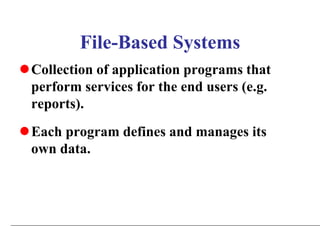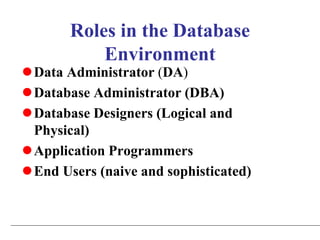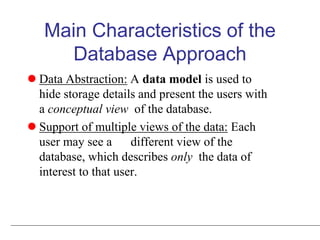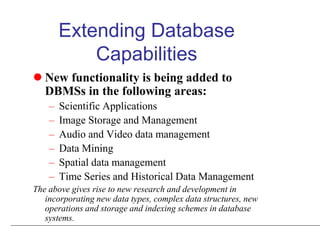Database Concepts.ppt
- 1. Introduction to DB Introduction and Conceptual Modeling
- 2. Objectives Some common uses of database systems. File-based systems. Typical functions of a DBMS. Major components of the DBMS environment. History of the development of DBMSs. Advantages and disadvantages of DBMSs Three-level architecture
- 3. Examples of Database Applications Purchases from the supermarket Purchases using your credit card Booking a holiday at the travel agents Using the local library Taking out insurance Using the Internet Studying at university Many more …….
- 4. Types of Databases and Database Applications Numeric and Textual Databases Multimedia Databases Geographic Information Systems (GIS) Data Warehouses Real-time and Active Databases A number of these databases and applications are described later in the book (see Chapters 24,28,29)
- 5. File-Based Systems Collection of application programs that perform services for the end users (e.g. reports). Each program defines and manages its own data.
- 6. Limitations of File-Based Approach Separation and isolation of data – Each program maintains its own set of data. – Users of one program may be unaware of potentially useful data held by other programs. Duplication of data – Same data is held by different programs. – Wasted space and potentially different values and/or different formats for the same item.
- 7. Basic Definitions Database: A collection of related data. Database Management System (DBMS): A software package/ system to facilitate the creation and maintenance of a computerized database. Database System: The DBMS software together with the data itself. Sometimes, the applications are also included.
- 9. Typical DBMS Functionality Define a database : in terms of data types, structures and constraints Construct or Load the Database on a secondary storage medium Manipulating the database : querying, generating reports, insertions, deletions and modifications to its content Concurrent Processing and Sharing by a set of users and programs – yet, keeping all data valid and consistent
- 10. Typical DBMS Functionality Other features: – Protection or Security measures to prevent unauthorized access – “Active” processing to take internal actions on data – Presentation and Visualization of data
- 11. Components of DBMS Environment Hardware – PC, workstation, mainframe, a network of computers. Software – DBMS, operating system, network software (if necessary) and also the application programs. Data – Used by the organization and a description of this data called the schema. Procedures – Instructions and rules that should be applied to the design and use of the database and DBMS. People
- 12. Roles in the Database Environment Data Administrator (DA) Database Administrator (DBA) Database Designers (Logical and Physical) Application Programmers End Users (naive and sophisticated)
- 13. Example of a Database (with a Conceptual Data Model) Mini-world for the example: Part of a UNIVERSITY environment. Some mini-world entities: – STUDENTs – COURSEs – SECTIONs (of COURSEs) – (academic) DEPARTMENTs – INSTRUCTORs Note: The above could be expressed in the ENTITY- RELATIONSHIP data model.
- 14. Example of a Database (with a Conceptual Data Model) Some mini-world relationships: – SECTIONs are of specific COURSEs – STUDENTs take SECTIONs – COURSEs have prerequisite COURSEs – INSTRUCTORs teach SECTIONs – COURSEs are offered by DEPARTMENTs – STUDENTs major in DEPARTMENTs Note: The above could be expressed in the ENTITY- RELATIONSHIP data model.
- 15. Main Characteristics of the Database Approach Self-describing nature of a database system: A DBMS catalog stores the description of the database. The description is called meta-data). This allows the DBMS software to work with different databases. Insulation between programs and data: Called program-data independence. Allows changing data storage structures and operations without having to change the DBMS access programs.
- 16. Main Characteristics of the Database Approach Data Abstraction: A data model is used to hide storage details and present the users with a conceptual view of the database. Support of multiple views of the data: Each user may see a different view of the database, which describes only the data of interest to that user.
- 17. Main Characteristics of the Database Approach Sharing of data and multiuser transaction processing : allowing a set of concurrent users to retrieve and to update the database. Concurrency control within the DBMS guarantees that each transaction is correctly executed or completely aborted. OLTP (Online Transaction Processing) is a major part of database applications.
- 18. Advantages of Using the Database Approach Controlling redundancy in data storage and in development and maintenence efforts. Sharing of data among multiple users. Restricting unauthorized access to data. Providing persistent storage for program Objects (in Object-oriented DBMS’s – see Chs. 20-22) Providing Storage Structures for efficient Query Processing
- 19. Advantages of Using the Database Approach Providing backup and recovery services. Providing multiple interfaces to different classes of users. Enforcing integrity constraints on the database. Drawing Inferences and Actions using rules
- 20. Disadvantages of DBMSs Complexity Size Cost of DBMS Additional hardware costs Cost of conversion Performance Higher impact of a failure
- 21. Historical Development of Database Technology Early Database Applications: The Hierarchical and Network Models were introduced in mid 1960’s and dominated during the seventies. A bulk of the worldwide database processing still occurs using these models. Relational Model based Systems: The model that was originally introduced in 1970 was heavily researched and experimented with in IBM and the universities. Relational DBMS Products emerged in the 1980’s.
- 22. Historical Development of Database Technology Object-oriented applications: OODBMSs were introduced in late 1980’s and early 1990’s to cater to the need of complex data processing in CAD and other applications. Their use has not taken off much. Data on the Web and E-commerce Applications: Web contains data in HTML (Hypertext markup language) with links among pages. This has given rise to a new set of applications and E-commerce is using new standards like XML (eXtended Markup Language).
- 23. Extending Database Capabilities New functionality is being added to DBMSs in the following areas: – Scientific Applications – Image Storage and Management – Audio and Video data management – Data Mining – Spatial data management – Time Series and Historical Data Management The above gives rise to new research and development in incorporating new data types, complex data structures, new operations and storage and indexing schemes in database systems.
- 24. When not to use a DBMS Main inhibitors (costs) of using a DBMS: – High initial investment and possible need for additional hardware. – Overhead for providing generality, security, concurrency control, recovery, and integrity functions. When a DBMS may be unnecessary: – If the database and applications are simple, well defined, and not expected to change. – If there are stringent real-time requirements that may not be met because of DBMS overhead. – If access to data by multiple users is not required.
- 25. When not to use a DBMS When no DBMS may suffice: – If the database system is not able to handle the complexity of data because of modeling limitations – If the database users need special operations not supported by the DBMS.
Editor's Notes
- #5: 4
























